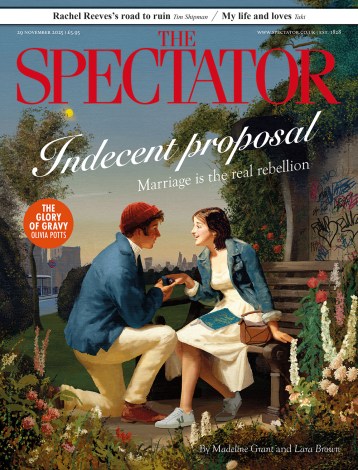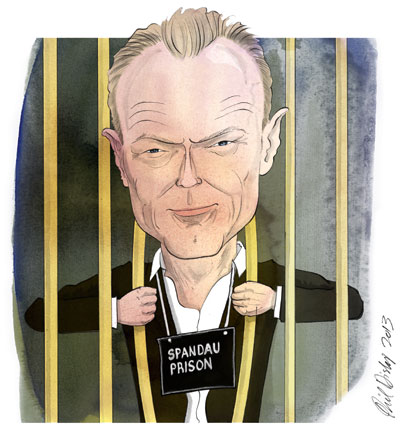There was a funny gaffe on Radio 4 the other day, when the newsreader announced that Hitler’s favourite architect Albert Speer had been banged up in ‘Spandau Ballet’. Cue a lot of laughter across middle England. Gary Kemp, the founder of Spandau Ballet, the 1980s pop band (not the Berlin prison) was also rather amused, even if he’d heard it before. ‘When we first started,’ he recalls, ‘the inky press thought our name meant we were a new fascist movement in music, which was obviously nonsense.’
The real inspiration behind the Spandau name was David Bowie. ‘We were obsessed with Berlin, which had been validated by Bowie. We all went to the Blitz club and bought synthesisers. Robert Elms turned round and said ‘How about Spandau Ballet?’ — it just sounded mysterious and glamorous. I later discovered Spandau is a really boring suburb of Berlin. Over here, we might have been called Neasden Ballet. Or Wandsworth Ballet. But we didn’t think we’d sell many records. We just wanted to be on Top of the Pops, once.’
Kemp’s formative years may have been spent in hair gel and glitter in Covent Garden, but now he’s a man in his early fifties of more distinguished tastes. He has an acclaimed collection of Victorian antiques, particularly those by E.W. Godwin, a giant house in Bloomsbury, and writes serious articles about David Bowie for the broadsheets.
He greets me at his door in a pair of Shipton & Heanage monogrammed slippers, which cost about £400. What would his younger self have thought of those, I wonder? ‘I think my younger self would be more amazed to know I was doing an interview for The Spectator,’ he says.
We walk past a colossal room — featuring a Steinway grand, a Sam Taylor-Wood photograph taken in the flat he used to own with his first wife (Sadie Frost), and a collection of racing bikes (he competes in the Étape due Tour, an amateur race along a stage of the Tour de France) — and ascend to an upper-floor drawing room elegantly set with Victorian aesthetic furniture, an etching by Augustus John, a Minton teapot and first editions of Aubrey Beardsley’s Golden Book.
Kemp grew up in a two-bedroomed rented flat with no bathroom and an outside loo off the Essex Road in Islington. His dad was a printer, his mother a dinner lady. He shared a bedroom with his younger brother (and fellow Spandau member), Martin. On Martin’s side of the room were Arsenal posters. On Gary’s, a dulcimer. His father made it for him.
‘My father had inklings of my cultural aspirations. He would take me to the library, things like that. But he wasn’t one of those dads who had read George Orwell and was a member of the Communist party. We had no books at home. We actually owned nothing. Everything in the house, apart from the living creatures in it, was on hire purchase.’ He remembers Green Shield stamps, and taking the lemonade bottles back for the 3p deposit. ‘We were totally and utterly skint.’
He had a Saturday job in the local grocer’s; a family stipulation was that he give his mother a third of his weekly £1.50 wage. ‘I can remember her crying because she couldn’t afford us new shoes.’
Things have changed quite a lot. ‘Yes,’ says Kemp, in his £400 slippers, ‘it’s amazing what a few pop songs can do.’
Yet even though he is surrounded by exquisite trophies, and admits he has invented a ‘middle-class environment’ for himself, he declines to call himself a self-made man in, shall we say, the Thatcherite mould.
‘I certainly wasn’t a fan of Thatcher’s politics. People liked to label us as children of Thatcher. What nonsense,’ he says. ‘The real children of Thatcher came in the 1990s, and had no interest in politics. The Oasis, Britpop scene,’ he says disdainfully.
Two things made him, he says. One was his parents. ‘We had a solid foundation of love and respect and encouragement, not pushy in any way. I never wanted to disappoint them.’
The second was his school. Dame Alice Owen’s was then a grammar school in Islington (it is now in Potter’s Bar). Arriving at the age of 11, he discovered a different world. ‘I met boys who had books at home, whose families read broadsheets, spoke about the theatre, had aspirations.’ he says. ‘We were aspirational kids too, we were reaching out further than our environment was allowing us. This is generally why the middle class gets the working classes wrong.’
‘Aspiration’ seems to be a Kemp motto. Gary describes ‘Gold’, his biggest hit, as ‘a feel-good James Bond theme tune, with an aspirational chorus. The anthem of Essex.’ The first Spandau Ballet concert was held in the canteen of Dame Alice Owen’s School. ‘You are going to blow your economics A-level, Kemp,’ warned his teacher. ‘My band is going to make it, sir,’ was the retort. A year later, a limo purred down the Essex Road to collect him and Martin for their first appearance on Top of the Pops.
Kemp is now chair of the committee organising the school’s 400th anniversary celebrations at the Albert Hall this April, a night in which Kemp will perform Gold along with his old school mate and Spandau vocalist, Tony Hadley. It will be a reunion in a number of ways; he and Hadley had a very expensive bust-up (an acrimonous court case over royalties, which Kemp won) and have spent a long time in a sulk, which Kemp is relieved to say has now thawed.
It all seems very establishment. From chirpy New Romantic to slipper-toting aesthete and feted Old Boy, who this year was given an Ivor Novello for songwriting. It can’t be long before he’ll be roped into a cultural think-tank at No 10. Would he want that?
‘If it was apolitical, of course you would. It’s always an honour doing anything for your country,’ he says, nicely. ‘But my vote still goes to Labour. I’ve always been a supporter, because of my father.’ Is he a member? ‘Currently, no, I am a bit ashamed to say. I was a David Miliband supporter, and was a bit disappointed that Ed got in. I still think Labour would have been better off with David. I think the Tories are going to lose the next election, rather than Labour winning it.… But what do I know? I just skim the Guardian every day!’






Comments